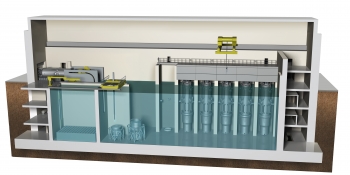
NuScale Power Reactors. ©NuScale Power, LLC, All Rights Reserved
Small Modular Reactors (SMRs) are nuclear power plants that are smaller in size (300 MWe or less) than current generation base load plants (1,000 MWe or higher). These smaller, compact designs are factory-fabricated reactors that can be transported by truck or rail to a nuclear power site. SMRs will play an important role in addressing the energy security, economic and climate goals of the U.S. if they can be commercially deployed within the next decade.
SMR Licensing Technical Support Program
Development of clean, affordable nuclear power options is a primary element of the DOE-NE’s Nuclear Energy Research and Development Roadmap, and SMRs are a key part of this strategy. Begun in FY12, the SMR Licensing Technical Support (LTS) Program has worked with industry partners, research institutions, the national laboratories, and academia to advance the certification, licensing, and siting of domestic SMR designs, and to reduce economic, technical, and regulatory barriers to their deployment. The SMR LTS program promotes the accelerated deployment of SMRs by supporting certification, licensing, and siting requirements for U.S. based SMR projects. The SMR LTS program originally supported the preparation and review of two design certification applications and the site licensing of one of those designs. Currently, it is supporting the preparation and review of one design certification application and furtherance of its first-of-a-kind engineering design, as well as two site licensing projects.
NuScale Power Partnership: DOE selected NuScale Power under an SMR funding opportunity announcement that sought innovative and effective solutions for enhanced safety, operations and performance beyond designs currently certified by the NRC. The NuScale SMR design offers an impressive mix of safety, scalability, transportability, and economics, as well as an advanced state of design maturity that should achieve commercial operation in the 2025 timeframe. DOE continues to work with NuScale to execute a cooperative agreement and measurable project goals.
Key Activities included in the agreement include:
- Complete the preliminary design by the third quarter of calendar year 2014
- Execute testing programs in support of design development and NRC review requirements
- Submit Design Certification application to the NRC by late-2016
- Complete reactor module final design by mid-2019
For more information visit NuScale Power.
SMR Siting Projects: The Department has also awarded the following site permitting and licensing projects:
- A five-year Interagency Agreement (IA) with TVA to support an Early Site Permit application and its review by the Nuclear Regulatory Commission, and later, a combined Construction and Operating License Application (COLA). This agreement was finalized in July 2015.
- An approximately 3-year Cooperative Agreement with NuScale and their subrecipient UAMPS to conduct site characterization activities and to prepare documentation, such as the Final Safety Analysis Report, the Environmental Report, and the Security Plan, that will lead to a COLA. This award was finalized August 11, 2015.
Further information on siting projects.
Support in Resolving Generic SMR Issues: Demonstrating the viability of SMRs will require overcoming many technical, regulatory, financial and institutional challenges. The program has conducted several studies and analyses supporting the resolution of generic licensing, economic, and commercialization challenges that may be faced by both near-term licensable and advanced, next-generation SMR designs and concepts. The concepts were vetted with industry stakeholders to assure that there was general agreement on the intrinsic value, and the studies were commissioned using a small portion of the SMR LTS program budget.
Additional information on efforts to resolve licensing, economic, and commercialization challenges.
B&W mPower America Design Certification Project: In 2013, the Department entered into a Cooperative Agreement with B&W mPower America, which teamed with Bechtel Power and the Tennessee Valley Authority, to develop and submit a Design Certification Application for the mPower reactor, and to develop the site permitting necessary to build it at TVA’s Clinch River site. In late February 2014, B&W Corporate announced it was reducing its investment in B&W mPower to “up to $15 million per year.” The Department continued the award at a reduced funding amount until the end of November 2014 while B&W mPower searched for investors. The award is still open but the Department has not provided any funding since December 2014.
